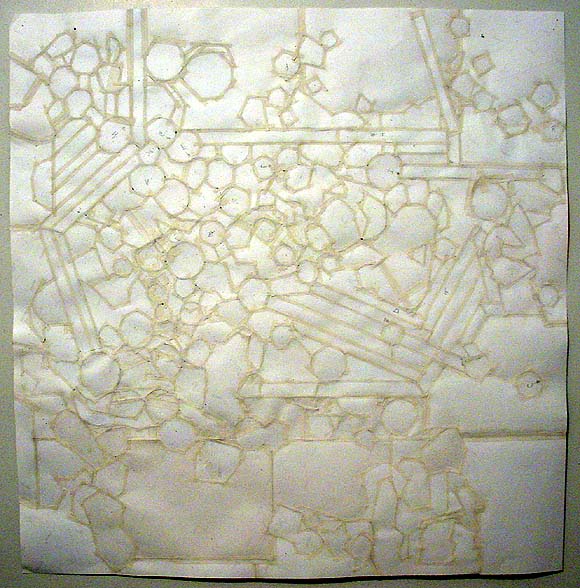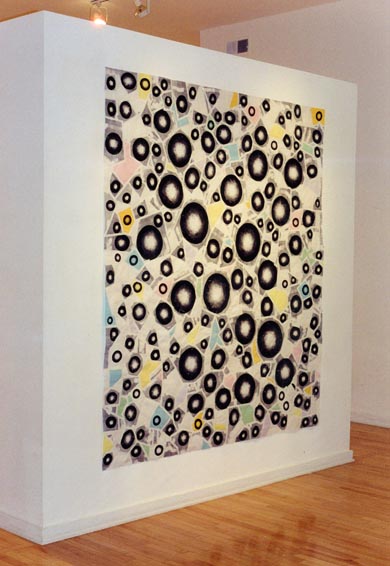Regarding my artwork in the previous post, Kara had these questions:
--Have you photographed the backs of any of these? I'd be curious to see this nest of webs.
--BTW, how light safe or fade-proof is the ink you're using? On pieces of this type, I'm using lightfast inks (pigments as opposed to dyes) and framing the work behind UV-resistant plexiGlas. No fading has occurred. I like having them around to look at.
This is the back of a similar piece I posted a while back:

She also wondered what one might be missing by seeing my object-type artwork on the Internet. I'd say what you're getting is about 60% of the experience. But it sure beats mailing f*ing slides.
So these pieces are not even layered, in the sense that they are collaged on top of each other, rather cut out and taped back together as puzzle pieces might be?
What kind of paper do you use?
These are wonderful from the back as well as the front. Framing with the option of viewing the back would be nice...
"Framing with the option of viewing the back would be nice..."
the back is a byproduct of the fabrication process. what are you going to do, flip it over to show people ? hang it backwards part of the time ? i think tom is being very patient with his friend and walking her through his process. but said friend needs to come up to speed with toms process quickly. and that will mean giving up allot of her safety-blanket flavored preconceptions about what art has to be to be good art. its archival paper. ok? hes not a dolt!
>>>So these pieces are not even layered, in the sense that they are collaged on top of each other, rather cut out and taped back together as puzzle pieces might be?
It's both. There is layering, as in running the paper through the printer multiple times (plus layering in the computer that mimics/relates to that layering), and there is cutting and moving things around and reassembling parts like puzzle pieces (plus cutting in the computer that mimics/relates to etc). The ultimate result confounds the eye (pleasantly I think) with a kind of gaming and punning between the physical and the virtual. Online you lose some of that interplay.
As for the backs, when you see them in real space, you see the seams from the front and can deduct the underlying structure from that. I have done pieces where the tape-network is visible on the front as well:

Bill is a friend who has heard me frequently complain about the challenges of getting the work across, both online and in the galleries. Kara is also a friend, and I appreciate your interest in this work and just want to assure you that I am indeed a pro and while I'm breaking some rules having to do with what's "computer art" and what's "art art," I've worked on the gallery side too long not to have a basic knowledge of how to make work durable and appealing to look at in person.
As for the archivalness of the paper--some of the earlier work (such as the piece above) was done with a photocopier and would have to be handled very carefully over the years. I'm really not too concerned about that--right now that piece is rolled up in my studio and it looks great whenever I unroll it.
The stuff I'm doing now is on paper "meant to last," partly because I finally just couldn't stand always being asked that question. And I'm still getting asked that question!!
Artists and collectors need to be better Buddhists and live in the moment.
I don't mean to imply that your work wouldn't be archival, my interest in materials is completely selfish in that I'd like to know what you're using for my own personal studio practice. I understand though if you don't want to divulge any secrets.
As far as the images go, I agree much of the physical layering process is lost in transmission which simply makes me curious. They read well online but it's been a while since I've seen them in person. Thanks for taking me through it.
It's not that I'm being secretive, it's just the ticking off the exact paper specs isn't exciting enough for the razzle dazzle Internet. I'll be happy to email you with the particulars.
the faming a work to show both sides is not about cowtowing to anyone. It is simply that process has been an interesting part of artmaking for years. Framing a work to show the back if it is of interest is not completely uncommon. A two-sided work is usually hung so that one can walk around the work (the work is framed between glass and stands something in the room). If Tom or anyone thinks this is insulting, then he/they don't have to do it. I found the complexity of the front cutting and pasting as well as the back both beautiful and didn't think it compromised anything to show a small part of the process. The fact that Tom first does all this work on the computer and then takes it yet another step once printed is a wondeful part of his process, one that becomes even more visible when the back is shown at the same time as the front.
|
Regarding my artwork in the previous post, Kara had these questions: On pieces of this type, I'm using lightfast inks (pigments as opposed to dyes) and framing the work behind UV-resistant plexiGlas. No fading has occurred. I like having them around to look at.
This is the back of a similar piece I posted a while back:
She also wondered what one might be missing by seeing my object-type artwork on the Internet. I'd say what you're getting is about 60% of the experience. But it sure beats mailing f*ing slides.
- tom moody 1-17-2006 8:41 am
So these pieces are not even layered, in the sense that they are collaged on top of each other, rather cut out and taped back together as puzzle pieces might be?
What kind of paper do you use?
- kara (guest) 1-17-2006 9:35 pm
These are wonderful from the back as well as the front. Framing with the option of viewing the back would be nice...
- anonymous (guest) 1-17-2006 9:59 pm
"Framing with the option of viewing the back would be nice..."
the back is a byproduct of the fabrication process. what are you going to do, flip it over to show people ? hang it backwards part of the time ? i think tom is being very patient with his friend and walking her through his process. but said friend needs to come up to speed with toms process quickly. and that will mean giving up allot of her safety-blanket flavored preconceptions about what art has to be to be good art. its archival paper. ok? hes not a dolt!
- bill 1-17-2006 10:10 pm
>>>So these pieces are not even layered, in the sense that they are collaged on top of each other, rather cut out and taped back together as puzzle pieces might be?

It's both. There is layering, as in running the paper through the printer multiple times (plus layering in the computer that mimics/relates to that layering), and there is cutting and moving things around and reassembling parts like puzzle pieces (plus cutting in the computer that mimics/relates to etc). The ultimate result confounds the eye (pleasantly I think) with a kind of gaming and punning between the physical and the virtual. Online you lose some of that interplay.
As for the backs, when you see them in real space, you see the seams from the front and can deduct the underlying structure from that. I have done pieces where the tape-network is visible on the front as well:
Bill is a friend who has heard me frequently complain about the challenges of getting the work across, both online and in the galleries. Kara is also a friend, and I appreciate your interest in this work and just want to assure you that I am indeed a pro and while I'm breaking some rules having to do with what's "computer art" and what's "art art," I've worked on the gallery side too long not to have a basic knowledge of how to make work durable and appealing to look at in person.
- tom moody 1-17-2006 10:43 pm
As for the archivalness of the paper--some of the earlier work (such as the piece above) was done with a photocopier and would have to be handled very carefully over the years. I'm really not too concerned about that--right now that piece is rolled up in my studio and it looks great whenever I unroll it.
The stuff I'm doing now is on paper "meant to last," partly because I finally just couldn't stand always being asked that question. And I'm still getting asked that question!!
Artists and collectors need to be better Buddhists and live in the moment.
- tom moody 1-17-2006 10:52 pm
I don't mean to imply that your work wouldn't be archival, my interest in materials is completely selfish in that I'd like to know what you're using for my own personal studio practice. I understand though if you don't want to divulge any secrets.
As far as the images go, I agree much of the physical layering process is lost in transmission which simply makes me curious. They read well online but it's been a while since I've seen them in person. Thanks for taking me through it.
- kara (guest) 1-17-2006 11:01 pm
It's not that I'm being secretive, it's just the ticking off the exact paper specs isn't exciting enough for the razzle dazzle Internet. I'll be happy to email you with the particulars.
- tom moody 1-18-2006 12:03 am
the faming a work to show both sides is not about cowtowing to anyone. It is simply that process has been an interesting part of artmaking for years. Framing a work to show the back if it is of interest is not completely uncommon. A two-sided work is usually hung so that one can walk around the work (the work is framed between glass and stands something in the room). If Tom or anyone thinks this is insulting, then he/they don't have to do it. I found the complexity of the front cutting and pasting as well as the back both beautiful and didn't think it compromised anything to show a small part of the process. The fact that Tom first does all this work on the computer and then takes it yet another step once printed is a wondeful part of his process, one that becomes even more visible when the back is shown at the same time as the front.
- anonymous (guest) 1-18-2006 1:56 am